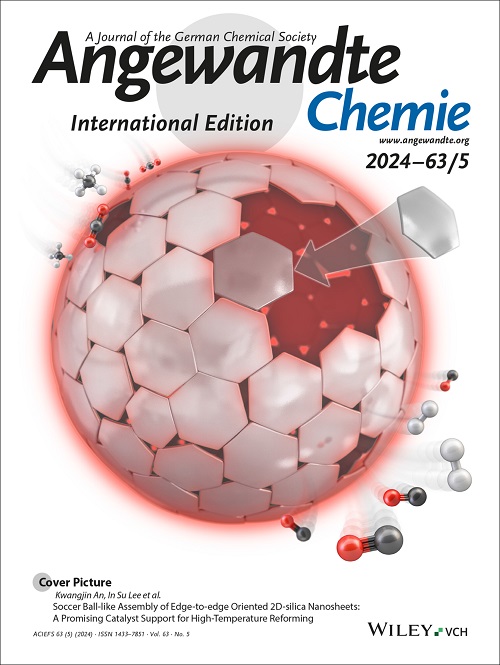用于x射线闪烁的稳定高核铜-炔纳米团簇的氢键辅助组装。
IF 16.9
1区 化学
Q1 CHEMISTRY, MULTIDISCIPLINARY
引用次数: 0
摘要
由于铜(I)-炔纳米团簇的高反应性和强聚集倾向,构建高核、原子精度高的铜(I)-炔纳米团簇仍然是一个巨大的挑战。在这里,我们报告了一种氢键辅助组装策略,可以在环境条件下合成两个坚固的铜(I)-炔纳米团簇。单晶x射线衍射显示了不同的核心结构,包括[(C2)8@Cu50] (Cu50)和[(C2)10@Cu56] (Cu56)。这两个簇都具有独特的金属壳,由协同Cu─C/O配位相互作用稳定,2-甲基-3-丁醇和CF3COO-配体的羟基之间有广泛的外层氢键网络,增强了分子的刚性和抗氧化性。值得注意的是,Cu50表现出强烈的黄色磷光和明显的x射线激发发光(XEL)。更重要的是,它代表了第一个被加工成闪烁体薄膜的高核铜纳米团簇,它表现出很好的x射线成像性能。本研究不仅建立了一种可推广的氢键辅助组装策略,用于构建稳定的高核铜(I)-炔纳米团簇,而且还证明了其在x射线闪烁中的实际适用性,为纳米团簇基材料的合成设计和功能多样化提供了新的见解。本文章由计算机程序翻译,如有差异,请以英文原文为准。
Hydrogen-Bonding-Assisted Assembly of Stable High-Nuclearity Copper(I)-Alkyne Nanoclusters for X-Ray Scintillation.
The construction of high-nuclearity, atomically precise copper(I)-alkyne nanoclusters remains a formidable challenge due to their high reactivity and strong aggregation tendency. Here, we report a hydrogen-bonding-assisted assembly strategy that enables the ambient-condition synthesis of two robust copper(I)-alkyne nanoclusters. Single-crystal X-ray diffraction reveals the different core structures including [(C2)8@Cu50] (Cu50) and [(C2)10@Cu56] (Cu56). Both clusters feature distinctive metal shells stabilized by synergistic Cu─C/O coordination interactions and an extensive outer-layer hydrogen-bonding network between the hydroxyl groups of 2-methyl-3-butyn-2-ol and CF3COO- ligands, enhancing molecular rigidity and inoxidizability. Notably, Cu50 displays strong yellow phosphorescence and prominent X-ray-excited luminescence (XEL). More significantly, it represents the first high-nuclearity copper nanocluster to be processed into a scintillator film, which exhibits promising X-ray imaging performance. The present work not only establishes a generalizable hydrogen-bond-assisted assembly strategy for constructing stable, high-nuclearity copper(I)-alkyne nanoclusters, but also demonstrates their practical applicability in X-ray scintillation, providing new insights into the synthetic design and functional diversification of nanocluster-based materials.
求助全文
通过发布文献求助,成功后即可免费获取论文全文。
去求助
来源期刊
CiteScore
26.60
自引率
6.60%
发文量
3549
审稿时长
1.5 months
期刊介绍:
Angewandte Chemie, a journal of the German Chemical Society (GDCh), maintains a leading position among scholarly journals in general chemistry with an impressive Impact Factor of 16.6 (2022 Journal Citation Reports, Clarivate, 2023). Published weekly in a reader-friendly format, it features new articles almost every day. Established in 1887, Angewandte Chemie is a prominent chemistry journal, offering a dynamic blend of Review-type articles, Highlights, Communications, and Research Articles on a weekly basis, making it unique in the field.

 求助内容:
求助内容: 应助结果提醒方式:
应助结果提醒方式:


